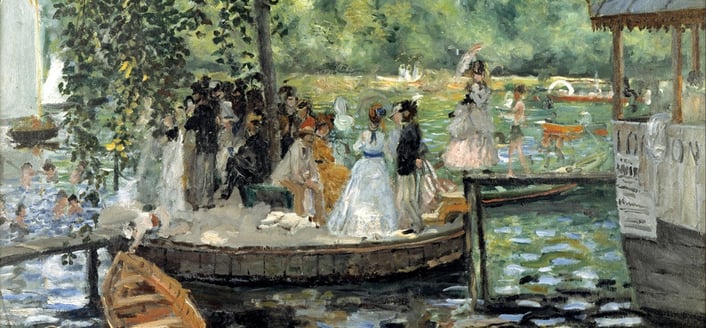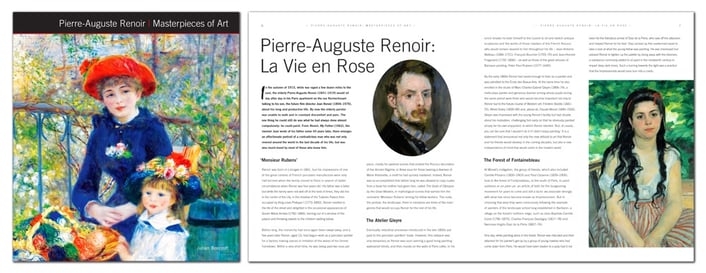
Pierre-Auguste Renoir was born in Limoges in 1841. His father was a tailor and his family lived in the centre of the city, in the shadow of the Tuileries Palace. Aged 13, Renoir had begun work as a porcelain painter for a factory creating pastoral pieces that evoked the Rococo decoration of the 'Ancien Régime', as well as likenesses of Marie Antoinette, a motif he had quickly mastered. In fact, Renoir was so accomplished that before long he was allowed to copy nudes from a book his mother had given him, called The Gods of Olympus by the Great Masters. This quickly earned him the nickname ‘Monsieur Rubens’ among his fellow workers. The nude, the portrait, the landscape: there in miniature are three of the main genres that would occupy Renoir for the rest of his life.
A Student of Art
Eventually, industrial processes introduced in the late 1850s put paid to the porcelain painters’ trade. However, this setback was only temporary as Renoir was soon earning a good living painting waterproof blinds, and then murals on the walls of Paris cafés. In his lunch breaks he took himself to the Louvre to sit and sketch antique sculptures and the works of those masters of the French Rococo who would remain dearest to him throughout his life – Jean-Antoine Watteau, François Boucher and the great virtuoso of Baroque painting, Peter Paul Rubens.
By the early 1860s Renoir had saved enough to train as a painter and was admitted to the École des Beaux-Arts. At the same time he also enrolled in the studio of Marc-Charles-Gabriel Gleyre , a meticulous painter and generous teacher among whose pupils during the same period were three who would become important not only to Renoir but to the future course of Western art: Frédéric Bazille, Alfred Sisley and, above all, Claude Monet. Gleyre was impressed with the young Renoir’s facility but had doubts about his motivation, challenging him early on that he obviously painted simply for his own enjoyment, to which Renoir retorted: ‘But, of course, you can be sure that I wouldn’t do it if I didn’t enjoy painting.’ It is a statement that announced not only the new attitude to art that Renoir and his friends would develop in the coming decades, but also a new independence of mind that would usher in the modern world.
Looking to Manet
At the time the only route to success for any young artist was through the Paris Salon, whose hanging committees had decided preferences for certain supposedly more serious genres of painting – above all, history painting. These were of no interest to Renoir and his group, who took their lead, above all, from Édouard Manet, whose paintings had shocked the Paris art scene by subverting the conventional genres with a new attitude to the world and its depiction.
Around then Renoir had achieved early and perhaps unexpected success with the Salon when his 'Dancing Esmeralda' was selected in 1864, but as soon as the exhibition was finished he destroyed the picture, a clear example of the independent spirit he would need to create a new kind of art. Although Renoir would in fact be drawn back time and again to the great tradition of painting for which the Salon believed it stood, the young painters had already committed themselves to depicting the ordinary life of the people they knew. Renoir, in particular, was drawn to the social life of Paris and its environs which they all enjoyed, and it was in this spirit in the early autumn of 1869 that Renoir and Monet set themselves down on the bank at La Grenouillère, a popular watering hole on the Seine just to the north-east of Paris where they often socialized themselves.
Instances of two great painters embarking simultaneously on a joint venture are fairly infrequent, so the pictures Monet and Renoir executed shoulder to shoulder at 'La Grenouillère' (detail, above) would constitute a fascinating historical moment even if they had been relatively conventional depictions. But the fragmentary paintings both of them made – in which the sense of a focal subject is dissolved in the dabs of colour and the reflected momentary light that pervade the scene – announced not only a new way of painting but a new way of seeing the world, like a brief glimpse imprinting itself on the mind. Or, as Renoir put it later with his customary flippancy:
‘One morning, one of us had run out of black; and that was the birth of Impressionism.’
If you're a fan of stunning masterpieces of art you'll love our new book, Pierre-Auguste Renoir. Packed full of insightful text all set alongside high quality images, this is the perfect book for any art lover. To take a closer look at the title, click here.




